
Fluxes/Diarrhea and Related Illnesses Page Menu: 1 2 3 4 5 6 7 8 9 10 11 Next>>
Treating Fluxes in the Golden Age of Piracy, Page 9
Treatment of a Flux: Internal Medicines - Cathartics
Cathartics are an unusual category of medicines to use for a flux given that they are forms of what we today call laxatives. This would seem to have the opposite effect of what is needed in a flux. However, sea surgeon John Moyle recommends them, the prescription for which I will repeat in full.

Sea Surgeon Author John Moyle
The Cure of it [diarrhea] only differs from that of a Dysentery in the Purging [here he means purging the bowels - we will later talk about purging the stomach via emetics], and all the rest of the Medicines serve indifferently for both, therefore I shall speak of them under the Dysentery.
First (and whilst the Patient has strength) purge with this following;
Rx. Syr[up] de spin. Cerv. [probably Syrupus de sperna Cervina or Syrup of the purging Thorn] {1 ounce}, Pulv[erized] Jalap. {half dram} Diagrid[ium – quince juice and scammony evaporated] {five grains} Vin. alb. [white wine] q. s. f. Haustus. [make a sufficient draught]
Let him drink it, and after it a little warm Broth, or Posset-drink, between each motion [stool]; 'tis an excellent Cathartick in this case.
...[This] unfurs the inner Tunnicles [vessels] of the first Passages [small intestines] and Bowels, and cleanseth the Stomach and whole Body effectually, of such rotten Flegm and Humours, as lye lurking therein, and cause this difference of Flux.1
Before explaining that prescription, there are a couple of interesting things worth commenting upon. First, note that Moyle only recommends cathartics in a diarrhea, not in a dysentery. Second, his stated purpose in administering a cathartic is to 'unfur' the intestines and bowels and 'cleanseth' the stomach and whole body of 'rotten Flegm and Humours.' So this really is a purge; one to remove all the bad stuff that Moyle suggests isn't leaving the system through the normal course of the diarrhea.
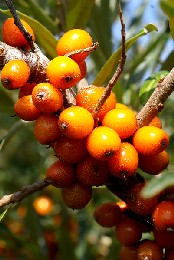
Photo: Hans Hillewaert
Sea Buckthorn Fruit
As for the purging medicines themselves, there are two in his recipe. The first is in the 'purging thorn' concoction. From Nicholas Culpeper, we learn that Syrupus de sperna Cervina with the concentrated juice of "Berries of purging Thorn [Hippophae or sea-buckthorn]" to which is added white sugar so that it can be made into a syrup. The syrup is then 'perfumed' with "Mastich, Cinnamon, Nutmegs, Anniseeds in fine powder"2. You may recall that some of those ingredients are astringent, which seems an odd thing to add to a cathartic. Then again, wikipedia lists astringency among sea-buckthorn's properties.3
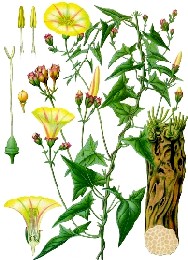
Artist: Franz Eugen Köhler
Scammony (1897)
The other cathartic ingredient is scammony, a part of the recipe for diagridium. Robert James tells us that scammony is obtained from the root of the plant and it's juice "is recockon'd one of the surest Purgatives tho', at the same time, one of the strongest; and therefore never given without a corrector."4 (The quince juice in the above recipe.)
Wikipedia explains how scammony actually works, explaining that that it "is inert until it has passed from the stomach into the duodenum [first part of the small intestine], where it meets the bile, a chemical reaction occurring... whereby it is converted into a powerful purgative."5
Nicholas Culpeper warns that it "is a desperate Purge, hurtful to the body by reason of its heat, windiness, corroding or gnawing and violence of working."6 Culpeper is clearly not a fan. Moyle is, however. He advises the sea surgeon reader, "observe this, that these Catharticks are not to be used only once and no more, but are often to be repeated as occasion requires, until the distemper is quite overcome."7 Yet he is the only period surgeon under study who does so.
1 John Moyle, The Sea Chirurgeon, p. 170-1; 2 Nicholas Culpeper, Pharmacopœia Londinesis, p. 127; 3 Hippophae, wikipedia, gathered 3/16/13; 4 Robert James, Pharmacopœia universalis, p. 434; 5 Scammony, wikipedia, gathered 3/16/13; 6 Culpeper, p. 47; 7 Moyle, p. 175
Treatment of a Flux: Internal Medicines - Cordials
Cordials are strengthening medicines, often alcoholic in nature. As James Rennie details, they " are prepared with wine or spirits, and aromatics [fragrant medicines]."1 Fellow herbalist Nicholas Culpeper explains why such medicines may have been useful in a flux. He believes that chyle "is carried to the heart with the blood that runs down in circulation, where it is changed into the sanguineous humour [new blood]: and hence the lacteæ of the thorax receive their restorative force from nutriment, cordials, and medicaments, out of the stomach or aesophagus,
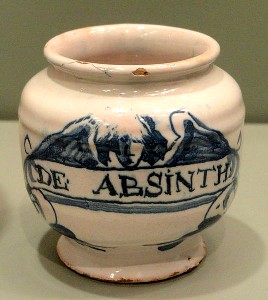
Photo: Daderot
1680 - 90 Apothecary Jar for Absinthe,
photographed
in the Gardiner Museum,
Toronto
by the glandulæ lactæe [lymph gland], and carry them straitway to the heart: whence it is, that drinking vinegar, wine, cordials, and other like things, so immediately causes the strength to be restored"2.
Sea surgeon John Woodall advised their use in every type of flux he discusses. He tells his readers for lienteries that the stomach "must be strengthned, both inwardly and outwardly, by things that corroborate and warme the same, as is sirupe de absinthio [absinthe syrup], or oleum absinthis, Chimice [absinthe oil] three or foure drops thereof in wine, or beere for neede"3. When discussing diarrhea, Woodall counsels the surgeon to "trie other good things: first all Aromatized strong waters [wines with herbs, roots, and/or spices added] are convenient in this case, moderately used as well to avoide further Fluxes, as also in these Fluxes to comfort the stomake, make stiptike wines serve well for it"4. In dysenteries, he suggests using "good Aqua vitæ [brandy], or some strong cordiall waters, if you see there bee cause to comfort and warme, and adding also, as is sayd, Deere suet {2 ounces} with waxe {half ounce}."5
Sea surgeon John Moyle is also a proponent of cordials in dysenteries. He explains that "this Dysentery Flux is a deplorable disease, and takes away the strength of the Patient, and brings him weak and faint; therefore there must be choice Cordials often given him to keep up his Heart, and dissipate the malign Vapours and Atoms that arise from the putridity of the Ulcerations [in the intestines]"6. He gives several suggestions on this front.
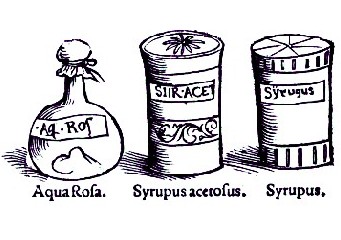
Cordial Apothecary Containers, Taken From Tacuini Sanitatisc
Elluchasem Elimithar Medici de Baldath, p. 111 (1531)
Rx. Aqua Cynamo [distilled cinnamon water] fort. Vel Rosa folis [fortified with Rosa folis] {2 drams}, in a small glass of burnt Wine.
This is very comfortable.
And truly, Claret Wine burnt with a good quantity of Cynamon and Mace [nutmeg], and a sprig of Mint, and Powder Sugar boyled in it; and so the Patient drinking two or three spoonfuls of it ever when he feels Heart qualms and faintness: I will assure you 'tis none of the meanest of Cordials.
But the very best of all others, is this:
Rx. Spir. Menthæ [spirit of mint] {1 dram}, aq. Cynamo-fort. {2 drams}, Syr. Caryoph. [syrup of cloves] {half ounce} misce, f. haustus. [mix to make a draught]
This given in a glass of Sack [fortified wine]; I am sure there is no better (for this distemper) in Nature.7
While our period sea surgeons see fit to give cordials in this case, not everyone is quite so enthusiastic about them. Surgeon Robert James positively rails against them. "In a word, the man who foolishly attempts to restore his Strength, or raise his Spirits, by this Method, has the Fate of him, who by blowing Fire, renders it indeed brisker, but at the same Time less durable, than it would otherwise have been."8 However, it was an easy cure at sea, being as simple as putting spices into wine as Moyle suggests or even giving the patient beer as Woodall notes.
1 James Rennie, A New Supplement to the Pharmacopœpias of London, Edinburgh, Dublin and Paris, Baldwin and Cradock, p. 96; 2 Nicholas Culpeper, Pharmacopœia Londinesis, p. 78; 3 John Woodall, the surgions mate, p. 202-3; 4 Woodall, p. 203-4; 5 Woodall, p. 210; 6 John Moyle, The Sea Chirurgeon, p. 175-6; 7 Moyle, p. 175-6; 8 Robert James, Pharmacopœia universalis, p. 169
Treatment of a Flux: Internal Medicines - Diaphoretics
Diaphoretics provoke sweat. You may recall that the quote which led the discussion of medicines from Thomas Aubrey cited diaphoretics as one of the things appropriate to a flux.1 Yet he is the only surgeon under study here that does so. Why is a mystery that he doesn't explain. On the face of it, it might be with the idea that sweat will remove liquids from the system and thus make the diarrhea less violent. However, if true, it would only have a mollifying effect, not a curing one.
1 Thomas Aubrey, The Sea-Surgeon or the Guinea Man’s Vadé Mecum. p. 77
Treatment of a Flux: Internal Medicines - Emetics (Purges)
"Hippocrates likewise assures us, that a Vomiting happening to one ill of a Diarrhoea, carries off the Distemper." (William Cockburn, The Nature and Cure of Fluxes, p. 96)
There was no ancient physician more esteemed than Hippocrates himself during this time, so when he assured the world that a vomit, brought on by administering an emetic or 'upward' purge would cure a flux, he set two millennia of such treatment in motion.
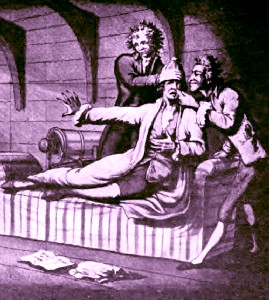
Taken from The British Tar in Fact and Fiction,
by Thomas Rowlandson, p. 254 (1800)
Hippocrates is so satisfied with the Success that attends this Method of Nature, that he thinks we ought always to give a Vomit when we would cure a Loosness... Hence it is plain, that, in Fact, vomiting is the Cure of a Diarrhœa; as also that a Diarrhœa is actually cured by vomiting and purging Medicines. The Reason of this Experience is likewise manifest from what has been shewn about the Nature and Causes of a Diarrhoea; because a Diarrhœa is often occasioned by sharp and stimulating Aliment [food] in the Stomach and Inteftins; and its Causes are unripe Fruit, indigested Food, &c. And therefore vomiting, and vomiting and purging Medicines, bring up, or carry downwards, the sharp Substances, in which consists the Nature of one Kind of a Diarrhœa; and, on that Account, are the Cure of Diarrhœa1
Indeed, if a flux is the result of having eaten something disagreeable, encouraging vomiting could be a way to cure this. However, as anyone who has ever had food poisoning can attest, time does the same thing naturally without having to go through the process of bringing the partially digested problem back up.
Sea surgeons John Moyle and John Woodall agree with the notion. Moyle tells us that first "the
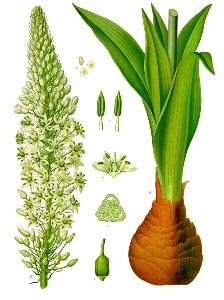
Artist: Franz Eugen Köhler
The Red Squill - Drima maritima (1897)
Stomach and first passages [small intestines] are cleared by a gentle Emetick,
as Oximel. selit. [Oxymel of squills - containing honey and vinegar of squills] {1 ounce}, in warm water"2. Woodall explains that "[a] vomitive medicine is not amisse in Fluxes whilst the party hath strength"3. Yet neither seem to link the concept of a purge with problems of food or 'stimulating causes' the way Cockburn does; they appear to be following the advice of the revered 'ancients'.
Woodall does recognize that a purge may not be appropriate in every case, however. Woodall explains that "if you conceive, or feare the disease to proceed of apostumation [formation of pus] in the stomake, then beware of giving any vomit before perfect supperation of the same, for it is deadly"4. He further warns his newly minted sea surgeon readers that "the young Artist may easily make an error, small in shew, which notwithstanding may quickly cost a man his life, wherefore if he attempt in such cases to cause vomite, as one principle let him have great care to the true dose of his medicines"4.
Cockburn agrees, likewise warning that "the Doses of these
Medicines must be adjusted to the particular Case of every Person; because a sick Person vomiting, or going to Stool, a determined Number of times in one Day, is under the Circumstances of one that has taken a Dose of these Medicines, sufficient to produce the like Effects. And therefore, the superadded Dose, which
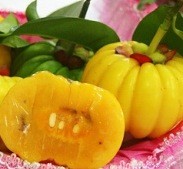
Camogia/ Gambooge/Brindle Berry
is to carry off this Quantity of Stimulus, must be adjusted to that End, and the Strength of the Person"5.
There are a variety of emetic medicines mentioned by our period medical authors. For example, when treating a patient with diarrhea, Woodall suggests that the surgeon "give him a vomit of the infusion of stibium [antimony], or rather of Salvitrioli, ten graines if it may be had, or of aquila vitæ foure graines, or of Camogia [probably gambooge or brindle berry] twelve graines, and so the medicine having done working, let him presently sleepe fasting, if hee can"6.
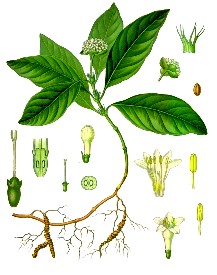
Artist: Franz Eugen Köhler
Ipecuanha Plant (1897)
William Cockburn notes that medical authors have historically recommended Salt of Vitriol - or boric acid for diarrheas. He goes on to explain that in more contemporary texts "the Salt of Vitriol gave way to the Ipecacuanha, either because it was a latter Invention, or that it was more agreeable, and was for a long time kept a great Secret."7
The first record of Ipecacuanha was by Dutch physician and naturalist William Piso (in Dutch, Willem Pies) who studied the plant and its effectiveness on dysentery, publishing his observations in the book Historia Naturalis Brasiliae in 1648. A large quantity of the root of the plant was sent to Paris from South America in 1672 by a physician named Legros.8 Word of the drug's efficacy in fluxes didn't really get out until some of it was given to Dutch physician Adriaan Jean Helvétius by one of his patients in France.9 Helvétius used it in several dysentery cases, keeping the name of the drug a secret so that he could be the sole purveyor. Among those treated were Louis XIV's son and several courtiers. Helvétius was granted sole right to vend the remedy by Louis XIV, but he sold the secret to the French government for a thousand loud d'or and they made the formula public in 1688.10
Cockburn goes on to list several other emetics as he did with the astringents. "The first are Pale-Roses, Mirobolans, and Tamarinds... Agarick [boletus igiarius], likewise Mechoacanna [Jalap], have a great Place among purging Medicines that have cured a Diarrhœa."12
1 William Cockburn, The Nature and Cure of Fluxes, p. 104; 2 John Moyle, The Sea Chirurgeon, p. 171; 3 John Woodall, the surgions mate, p. 215; 4 Woodall, p. 203; 5 Woodall, p. 215; 5 Cockburn, p. 107-8; 6 Woodall, p. 203; 7 Cockburn, p. 108-9; 5 Alfred Stillé, Therapeutics and Materia Medica Vol. 2, p. 443-4 9 Stillé, p. 444; 10 Stillé, p. 444 & Carapichea ipecacuanha - History, wikipedia, gathered 3/18/13; 12 Cockburn, p. 114
Treatment of a Flux: Internal Medicines - Emetics -- Myrobalans
In his list of emetics in the previous section, Physician William Cockburn includes 'Mirobolans'1, by which he means myrobalans, the fruit of a tree native to India. Sea surgeon John Woodall recommends for a patient with a particularly harsh dysentery "of an acrimonious fretting humor, then one of your first helps must be a present purge, if strength will beare it, namely of Rubarbe, as is said in the cure of Diarrhea, or a Decoction of myrabalans"2.
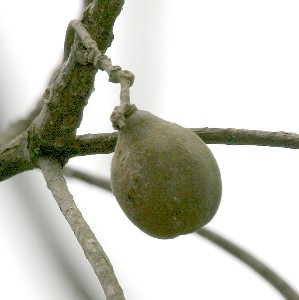
Artist: J. M. Garg
Myrobalan Terminalia Bellerica
All of the four pharmacopoeias have something to say about myrobalans, which is notable. James Rennie gives it the weakest entry explaining that it is "acidulous, feebly astringent, and cathartic. It is given in scorbutus, dysentery, &c."3 Physician John Pechey notes that there are "five Sorts of them... All of them cool, dry and are astringent... Being toasted, they purge a little and bind much, like Rubarb."4 Nicholas Culpeper reports that "[a]ll the forts of Mirobalane, purge the stomach... yet take heed you use them not in stoppings of the bowels they are cold and dry [astringent], they all strengthen the Heart, Brain and sinews, strengthen the stomach, relieve the senses, take away tremblings, and heart qualms."5 Robert James provides an even more precise explanation of their use in fluxes, telling his readers "they purge gently, and strengthen the Intestines at the same time; and therefore, are very proper in Diarrhæas and Dysentereis, and make a very good Succedaneum [substitute] for Rhubarb; only the Dose must be larger"6.
Robert James goes on to provide a detailed entry on the five myrobalans that is worth repeating here with some additional comments from John Pechey.
The first type he calls Myrobalanus Inda Ingra or black Myrobalans. He describes the fruit as "more slender and narrow than any of the rest, with eight Ridges upon the Superficies. They are rough, solid and hard, and black both within and without, of a subacrid, rough, and astringent Taste."7 Pechey calls them Indæ Black Cholar, the reference to black cholar which James refers to as black bile, one of the four bodily humors. Pechey details that when they are "toasted, they purge a little and bind much"8. Culpeper likewise advises that "the Indian Mirobalans are held to purge Melancholly [yet another name for black bile.]"9
The second myrobalan James discusses is Myrobalanus Citriose Flava.
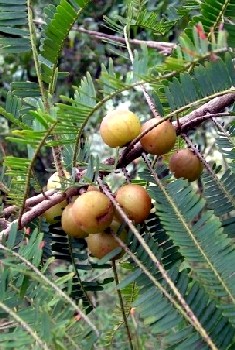
Artist: L. Shyamel
Myrobalan Phyllanthus Emblica
"This is an oblong, round, pentagonal, rough Fruit, of a Citron Colour, including an angular Stone under a carnous Bark."10 Pechey refers to this type of Myrobalan as a "Citrinæ" and notes that it is particularly useful as a purge for "Yellow Choler"11, which James explains is the bodily humor yellow bile.
The third, fourth and fifth myrobalans are grouped together by Pechey, who explains that they all "purge Flegm"12, another of the bodily humors. Culpeper and James agree. James does separate the three remaining myrobalans for purposes of his descriptions, however.
The third is the Myrobalanus Chebula [terminalia chebula]... This is an oblong rough Fruit, with five Ribs on the Superficies, including an oblong, thick, and cavernous Stone, under a carnous Bark. It is of a roughish Taste, and the largest of all the Myrobalans. The fourth is the Myrobalanus Bellerica [terminalia bellirica].... This is a round and somewhat angular Fruit, about the Sieze of a large Gall, containing a hard Stone, under a carnous Bark. It is of a subacrid and astringent and astringent Taste. The fifth is the Myrobalanus Emblica [Phyllanthus emblica].... This is a roundish black Fruit, flat at each End, sexangular, and easily separating into six Parts, containing an hexagonal, round, white Stone, divided into six Cells.13
Not many plants are so closely identified with the ability to purge the various bodily humors, let alone having various species of a group purge individual humors.
1 William Cockburn, The Nature and Cure of Fluxes, p. 114; 2 John Woodall, the surgions mate, p. 208; 3 James Rennie, A New Supplement to the Pharmacopœpias of London, Edinburgh, Dublin and Paris, Baldwin and Cradock, p. 262; 4 John Pechey, The Compleat Herbal of Physical Plants, p. 300; 5 Nicholas Culpeper, Pharmacopœia Londinesis, p. 42-3; 6 Robert James, Pharmacopœia universalis, p. 375; 7 James, ibid.; 8 Pechey, ibid.; 9 Pechey, ibid.; 10 James, ibid.; 11 Pechey, ibid.; 12 Pechey, ibid.; 13 James, ibid.
Treatment of a Flux: Internal Medicines - Emetics -- Rhubarb
"...if the Strength of the Sick admits of an evacuating Medicine, we may recommend a Purge of Rhubarb among the best and safest of the Kind." (William Cockburn, The Nature and Cure of Fluxes, p. 289)

Artist: Anders Sandberg
Rhubarb - Rheum Rhabarbarum
Just about every period medical author who recommends an emetic in the cure of a flux suggests the use of rhubarb. Robert James calls it "one of the best and mildest" of emetics. He explains it "is found by certain Experience, to evacuate the Bile, preferably to any other Fluid."1 Fellow physician Nicholas Culpeper agrees explaining that it "gently purgeth choler from the Stomach"2. In this way it is like the myrobalans according to the period authors, although they don't credit it with the ability to remove flegm.
All three of the period herbalists who suggest it give basically the same recommendation, albeit in different words. John Pechey states that it cures "the Bloody-Flux. 'Tis reckon'd to purge first, and bind afterwards."3 Robert James find it bo be "good in a Looseness, because it purges and strengthens at the same time."4 Nicholas Culpeper explains that "it purgeth but gently, it leaves a binding quality behind it, therefore drid [dried] a little by the fire, and beaten into powder, it is usually given in fluxes."5
Even physician William Cockburn comments on this purging/binding one-two punch, advising that " Rhubarb, no doubt, is to be preferr'd to the other purging Medicines, because it is likewise endued, with a binding Quality, whereby it leaves every one bound that takes it in Health, and must therefore have some such Effect in a Diarrhœa."6
Indeed, the purging/binding facet combined with the ability to purge the bile [yellow and black] humors make rhubarb root ideal for use in fluxes according to John Moyle.
Now to perform this work, Purging of Choler and putrid Humours is requisite; and these Medicines made of Rhubarb, are known and experienced to be best, because that not only purges Choler, but also leaves a restrictive quality behind it; yet it must have mixed with it such ingredients as oppose Venenosity [poisoning], and corroborate the Heart.7
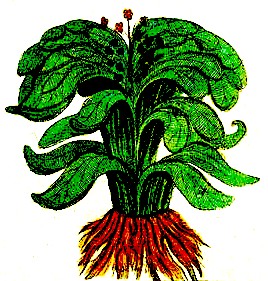
Artist: Michael Boym
Rhubarb Plant with Roots, From Bibliothèque
Universtaire Moretus
Plantin (1656)
Fellow sea surgeon John Woodall agrees, because "experience teacheth that Rhubarb in what manner soever we administer the same, (but especially the infusion thereof) is very commodious and profitable in this disease [diarrhea]"8. He prescribes it thus for a diarrhea, "First give him {2 scruples} of Rubarb dried as they use to drie Tobacco, and poudered either in wine or Carduus [water], or faire water [clean, pure water], or the infusion thereof"9.
For pain in the stomach (griping), Woodall suggests "a dose of Rubarbe, namely {2 scruples} or {half dram} parched and powdered fine, for so it doth best, taken either alone, or with Sanguis prunellorum [juice of sloes] one small spoonefull in wine, and a little Cyanmon water, or in any other convenient drinke, as the present state of the sicke shall cause thee."10 Physician Thomas Aubrey also recommends "the Patient be purged moderately with Rhubarb" to assist with "those remarkable and painful Gripes which are a most constant Symptom of this Disorder"11..
1 Robert James, Pharmacopœia universalis, p. 418; 2 Nicholas Culpeper, Pharmacopœia Londinesis, p. 11; 3 John Pechey, The Compleat Herbal of Physical Plants, p. 320; 4 James, ibid.; 5 Culpeper, ibid.; 6 William Cockburn, The Nature and Cure of Fluxes, p. 52; 7 John Moyle, The Sea Chirurgeon, p. 173; 8 John Woodall, the surgions mate, p. 207; 9 Woodall, p. 204; 10 Woodall, p. 210; 11 Thomas Aubrey, The Sea-Surgeon or the Guinea Man’s Vadé Mecum., p. 75
Treatment of a Flux: Internal Medicines - Emetics -- Use of Purges in a Lientery
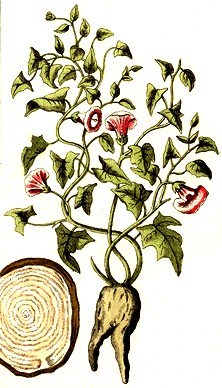
Artist: Johannes Zorn
Ipomoea purga or Convolvulus
Mechoacanna - aka Jalap
Physician William Cockburn starts off a discussion on using emetics in a lientery by explaining that "Vomiting is always to be avoided in Cases
of a Lientery, however useful they sometimes are in the Cure of a Diarrhœa"1.
That seems very clear and forthright and we are now assured that purges shouldn't be used. Until he explains that "Purging Medicines have been much commended for curing a Lientery."2 So it is either to be avoided or commended, pick your favorite.
Cockburn gives several recipes for purges for a lientery including a complex concoction containing chicory root, absinthe, rhubarb and syrup of limes. The active purging agent in this recipe being the rhubarb, as we have seen.
Cockburn also notes that 16th/17th century Daniel Sennert says "Rhubarb steep'd in Rose-Water is a powerful Remedy for a Lientery."3 He finishes with a "purging Powder [which] is well esteemed among Physicians" containing pulverised jalap root.4
1 William Cockburn, The Nature and Cure of Fluxes, p. 226-7; 2 Cockburn, p. 232; 3 Cockburn, p. ibid.; 4 Ibid.

